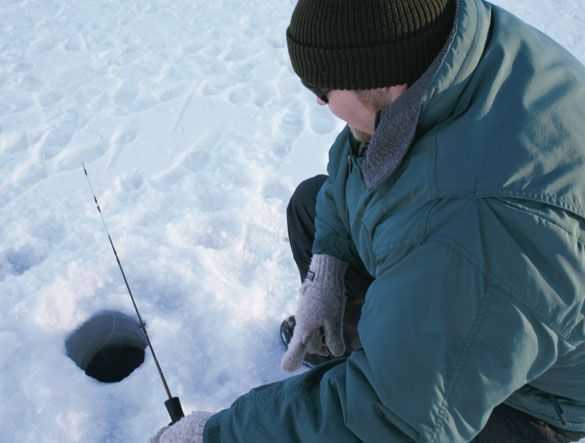By: Captain John Bunar, Coastal Angler Staff Writer
I just can’t understand why a person who really enjoys fishing would not try ice fishing. Ice fishing provides an opportunity to get some exercise out in the freshest and cleanest air we have all year. Ice fishing also has a track record of being the most under-rated kids activity in new england; I have yet to take a child ice fishing and not had him or her get hooked in one day. Whether you are looking for some peace and quiet in the outdoors, or you need to have a gaggle of 10 year-olds burn up some energy, ice fishing is a great solution. If you try it, you will love it.
Since the popularity of catch and release took over 20 years ago, the freshwater fishing in our area has become spectacular. Targeting bass, pickerel, and perch will bring quick success, but those wishing for more of a hunt can fish for trout, salmon, and pike. The main method of ice fishing is the use of tip-ups; jigging rods are another method of ice fishing, but beginners should master the tip-up first. Although tip-ups come in all different styles and materials, their basic premise is the same; they hold a bait at a prescribed depth, and then indicate, via the release of a flag, when a fish has taken the bait. I enjoy getting flags, and the exercise of chasing them all day, so I target ponds with healthy stocks of bass, pickerel, and perch. I use medium sized bait to encourage any hungry critter under the ice to take a bite, because bigger bait does not mean bigger fish; it simply means less small fish.
The basics needed to start ice fishing are 5 tip-ups, a chisel or hand auger, sled, ice scoop, bait bucket and the clothing and boots to keep warm. All you need for terminal tackle is some small barrel swivels, size 2-2/0 hooks, 20 lb. mono leader, and some non-lead split shots. rigging tip-ups is simple; fill the spool on the tip-up with coated line until 3/4 full. Slide on a depth indicating button, and tie a barrel swivel on the bitter end. A 2 foot piece of mono tied onto the swivel is all you need for a leader; use a split shot a few inches below your swivel to help your bait get down through the hole.
When fishing, I like to space my holes at least 50 feet apart. I usually hang my bait 12-15 inches over the bottom, and set the button so I can return to that depth easily. I hook my bait (minnow) just under the skin in front of the dorsal fin. It is important to check the bait in the first hour of fishing to make sure it does not get into the weeds. If I check a bait and it has weeds, I will bring it up a few inches and check it soon after to make sure it is still fishing clean. A beginner ice fisherman doesn’t need
to worry about a steep learning curve in the fishing sense.
The fish are easy to catch, and there are tons of ponds with great fishing everywhere. everyone needs to learn the do’s and don’ts of ice safety, because with penalties second only to fire, ignoring the common sense rules of ice safety can put you in a dangerous situation. Since worrying about the safety of the ice would ruin the fun of a day, I never bother to go ice fishing unless I have 5 solid inches of ice. I also spend time checking ponds as they freeze, because I want to know if geese, ducks, wind, etc., kept an area of a pond from freezing as quickly.
I always check the ice with a chisel as I venture out on a body of ice for the first time, and if there is snow on the ice, I check very often. even when I’m feeling very good about the ice I am on, I still carry a boat fender on 75 feet of line in my sled; combine the above with never going on the ice alone and you can feel confident about your safety. For the first trip or two, I recommend you go with an experienced ice fisherman to answer any questions and allay any worries. I look forward to seeing you on the ice!
[easy-social-share]
